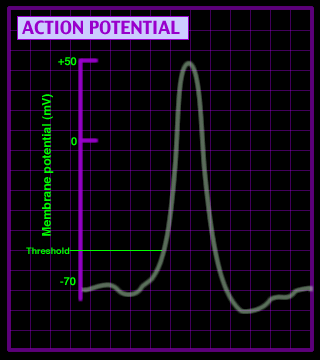
“The graph below shows how the voltage of the neuron changes during the neural impulse. You can see that the voltage rises quickly and then falls again. When the sodium ions are flooding into the neuron, we say that it is depolarizing. This just means that the neuron starts off being polarized and then becomes less polarized.

“Once the neuron becomes positively charged, the sodium ion channels close and the potassium channels open. As the potassium ions exit, the line on the graph descends rapidly toward the resting potential. Can you see why the action potential we’ve described is sometimes called the spike potential?
“Finally, as you continue to study the graph, you see that too much recovery occurs, and the line actually goes beyond the resting potential, maybe to -80 mV or so. If we call -70 mV polarization, and anything less than this (i.e., closer to zero, such as -60 mV or -55 mV) depolarization, then what will we call greater polarization than usual?”
Mindstein seems content to answer his own question. “We call this hyperpolarization.”